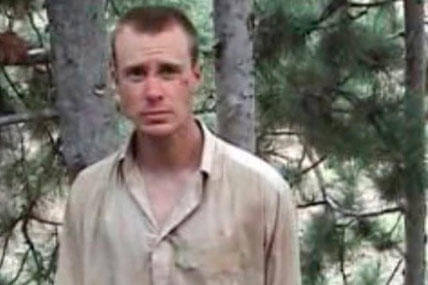Several troops may have been killed in missions related to the search for Sgt. Bowe Bergdahl, who allegedly became disillusioned with the war and walked away from his outpost in Afghanistan in 2009.
The Pentagon would not initially confirm published reports that at least six troops from Bergdahl's unit were killed in the recovery missions after he went missing on June 30, 2009, and was taken prisoner by the Taliban.
"It's impossible for me to confirm that," said Army Col. Steve Warren, a Pentagon spokesman. "We know there are some names out there. We'll look into it."
If troops were killed looking for Bergdahl, they were heroes, Warren said.
"Our warrior creed says simply we will never leave a fallen comrade. That is our ethos," Warren said.
Bergdahl went missing while serving in Paktika province with the 1st Battalion, 501st Parachute Infantry Regiment, 4th Brigade Combat, 25th Infantry Division out of Fort Richardson, Alaska.
From June 30 through Sept. 11, 2009, six members of the 1st Battalion were killed in Paktika province, according to Defense Department records and the icasualties.org website.
Those deaths came from searches for Bergdahl, according to Nathan Bradley Bethea, a former 1st Battalion officer who now teaches creative writing at Brooklyn College.
"Bergdahl was a deserter and soldiers from his own unit died trying to track him down," Bethea wrote in an article for the Daily Beast.
In the searches, "I remember the soldiers involved asking why we were burning so much gasoline trying to find a guy who had abandoned his unit in the first place," Bethea wrote.
On Sunday, Sgt. Matt Vierkant, a member of Bergdahl's platoon, told CNN that Bowe Bergdahl "deserted during a time of war and his fellow Americans lost their lives searching for him."
Bergdahl allegedly left behind his weapon and body armor when he went missing. He reportedly had become disillusioned with the U.S. conduct of the war and said he was "ashamed to be an American."
However, in a video released by the Taliban a month after his capture, Bergdahl said "I am scared, I am scared I will not be able to go home. It is very unnerving to be a prisoner."
The military conducted a series of investigations on the circumstances of Berdahl's capture, but did not reach a conclusion on whether he was a deserter because Bergdahl's input was lacking, Warren said.
Bergdahl's family has not yet retained a lawyer for him and currently there was no Article 15 investigation under the Uniform Code of Military Justice to determine whether court martial charges were warranted, Warren said.
The 28-year-old Bergdahl was still considered a member of the 1st Battalion and would be welcomed back there if the Army determined that he was physically and psychologically fit, said Capt. Charles Spears, a spokesman for U.S. Army-Alaska.
"Of course, we'd welcome a member of our team," Spears said.
Bergdahl, who has yet to speak with his parents, was released Saturday in southeastern Khost province when Taliban fighters turned him over the Special Forces troops.
In return, the U.S. released five top-ranking Taliban prisoners from the Guantanamo Naval Base in Cuba and flew them by military aircraft to the Gulf state of Qatar. The Qataris have agreed to bar the five from traveling for at least one year.
Bergdahl currently was at the main medical facility at Ramstein Air Force Base in Germany where he was in Phase I of a three-step recovery process, Warren said.
Defense Secretary Chuck Hagel and White House officials have said that a main factor in moving swiftly to obtain Bergdahl's release was concern that his deteriorating physical condition might be life threatening.
However, Warren said Bergdahl was listed in stable condition.
"He has nutrition issues. He hasn't eaten well over the last five years," Warren said.
The first phase of Bergdahl's recovery involved diagnoses from psychologists assigned to the military's Survival Evasion Resistance and Escape (SERE) units for lessons to be learned from his time in captivity, Warren said.
Bergdahl was also being debriefed by intelligence officers.
"Initially now the focus is on how he was held in captivity," Warren said.
The second phase of the recovery involved bringing him back to the United States to the Brooke Army Medical Center in Texas. The third phase involved "giving him the opportunity to tell his story," Warren said.
-- Richard Sisk can be reached at richard.sisk@monster.com





























